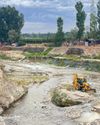Over 60 years after the country got its first plan to rejuvenate the rivers, not a single basin has been spared from over-exploitation

All the 20 river basins of the country share the story of the Cauvery: how human interference has changed every river’s form and flow pattern over the past few decades.
Water in the country’s three major rivers—the Indus, the Brahmaputra, and the Ganga—has plummeted drastically. Central Water Commission’s 2017 data shows that between 1984-85 and 2014-15 water in the Indus dropped by 27.78 billion cubic meters (BCM), almost equal to the average water available in the Cauvery during this time. In the Brahmaputra, it dropped by 95.56 BCM and in the Ganga by 15.5 BCM. The report shows another disturbing trend: between 2004-05 and 2014-15, the catchment area of the Indus reduced by 1 percent, that of the Ganga by 2.7 percent, and of the Brahmaputra by 0.6 percent. The per capita surface water availability also dropped from 5,200 cubic meters in 1951 to 1,588 in 2010.
The Ganga basin, the country’s largest river basin, is degraded as forest areas are rapidly transforming into agricultural and urban lands. It is alarming that in the lower parts of the basin—in Madhya Pradesh, Rajasthan, Jharkhand and West Bengal— land in many areas has turned barren.
Rampant deforestation has cost the Ganga over 1,500 billion cusecs water near the Himalayas, says Prakash C Tiwari, lead author of a 2015 study on the Himalayan basin conducted along with the Australian National University of Canberra. It is, therefore, not surprising that along with the Ganga, the flow of its major tributaries has also slowed down. Between 2005-2006 and 2014-2015, the flow of Sone and Ramganga reduced the most—69 and 55 percent respectively, shows an analysis by Delhi-based think tank Centre for Science and Environment.
この記事は Down To Earth の August 01, 2019 版に掲載されています。
7 日間の Magzter GOLD 無料トライアルを開始して、何千もの厳選されたプレミアム ストーリー、9,000 以上の雑誌や新聞にアクセスしてください。
すでに購読者です ? サインイン
この記事は Down To Earth の August 01, 2019 版に掲載されています。
7 日間の Magzter GOLD 無料トライアルを開始して、何千もの厳選されたプレミアム ストーリー、9,000 以上の雑誌や新聞にアクセスしてください。
すでに購読者です? サインイン

In leading role again
MOVIES AND WEB SERIES ARE ONCE AGAIN BEING SET IN RUSTIC BACKGROUNDS, INDICATING A RECONNECT BETWEEN CINEMA AND THE COUNTRYSIDE

One Nation One Subscription comes at a huge cost
As top US universities scrap big deals with top scientific publishers, India’s ONOS scheme seems flawed and outdated

Return of Rambhog
Bid to revive and sell the aromatic indigenous paddy variety has led to substantial profits for farmers in Uttar Pradesh's Terai region

Scarred by mining
Natural springs of Kashmir drying up due to illegal riverbed mining

Human-to-human spread a mutation away
CANADA IN mid-November confirmed its first human case of avian influenza, with a teenager in the British Columbia being hospitalised after contracting the H5N1 virus that causes the disease. The patient developed a severe form of the disease, also called bird flu, and had respiratory issues. There was no known cause of transmission.

True rehabilitation
Residents of Madhya Pradesh's Kakdi village take relocation as an opportunity to undertake afforestation, develop sustainable practices

INESCAPABLE THREAT
Chemical pollution is the most underrated and underreported risk of the 21st century that threatens all species and regions

THAT NIGHT, 40 YEARS AGO
Bhopal gas disaster is a tragedy that people continue to face

A JOKE, INDEED
A CONFERENCE OF IRRESPONSIBLE PARTIES THAT CREATED AN OPTICAL ILLUSION TO THE REALITY OF A NEW CLIMATE

THINGS FALL APART
THE WORLD HAS MADE PROGRESS IN MITIGATING EMISSIONS AND ADAPTING TO CLIMATE IMPACTS. BUT THE PROGRESS REMAINS GROSSLY INADEQUATE